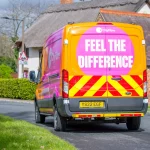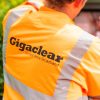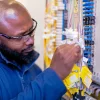ITU Nears Completion of New 50Gbps FTTH Broadband Standard

The International Telecommunication Union will this year complete the development of its new “Higher Speed Passive Optical Network” (G.9804 series / G.hsp) technology – 50G-PON, which will make it possible for future FTTP broadband ISP networks to deliver speeds of 50Gbps (Gigabits per second).
Admittedly, the UK today may still be a fair few years away from seeing 1Gbps capable Fibre-to-the-Premises (FTTP) broadband ISP networks achieving almost universal coverage, so any talk of faster speeds may cause some eyes to roll skyward. But that attitude has never and should never stop the wider evolutionary march of technology, which doesn’t take a break just so that one of the slowest country’s to adopt can catch up.
Broadly speaking, the new Higher Speed PON standard includes both single-channel 50Gbps systems to succeed 10Gbps capable XG(S)-PON and multi-channel 50Gbps systems to succeed NG-PON2 (40G PON, at 10Gbit/s per wavelength). The new standard was largely agreed back in 2019 and, ever since then, the ITU’s Study Group 15 team has been busy developing the details of how it will work.
Advertisement
The change represents another gradual evolution, rather than revolution, from the original Gigabit PON (G-PON) standard – 2.4Gbps download, 1.2Gbps upload (shared capacity) – and those that followed it a few years back (see above). Indeed, it’s designed to work with the same fibre plant as G-PON, XG(S)-PON and NG-PON2, although to get the best speeds you may still need to replace some existing kit.
One of the biggest changes this time around has been the adoption of Digital Signal Processing (DSP) into the standard, which may seem surprising given how common DSP has become in other communication standards. But the reality, until now, has been that for systems operating at 10Gbps or lower, DSP simply wasn’t needed (this is down to the nature of fibre optic transmission).
Frank Effenberger, Rapporteur for ITU’s Related Working Group, said:
“DSP provides so much advantage that 25G-bandwidth optics can be used to produce a 50G system. This improves the cost profile of the system because DSP shifts the difficulty from the optical domain, where it’s hard to cost reduce, to the digital domain where cost reduction is inevitable due to Moore’s Law.
We strongly believe that 50G PON will provide the right capacity, at the right price, and at the right time.”
The ITU said they’re now targeting completion of all the necessary standards work by the end of 2021 – previously this was anticipated for 2020, but that was before COVID-19 hit. But commercial market demand isn’t likely to follow until 2024, as it tends to take time to turn new standards into final hardware and then for that market to start demanding such upgrades.
At present, you can already find a few countries where 10Gbps and even 20Gbps home broadband packages are being promoted (many of those are in the Asian Pacific region), and it’s those that will probably be among the first to shift their focus to 50Gbps in the future (shared capacity). A precious few UK ISPs do offer 10Gbps to homes (e.g. B4RN), but only provided you’re willing to pay quite a bit of money and are covered by their network.
Advertisement
The catch is of course that most people would struggle to fully harness a 1Gbps FTTP connection today (Why Buying Gigabit Broadband Doesn’t Always Deliver 1Gbps), let alone 10Gbps, 20Gbps or even the dizzying heights of 50Gbps (this is over a single wavelength). But this development just goes to show that optical fibre, once it’s in the ground, has a lot of room to evolve and there’s plenty of scope for more standards to continue that push (one of these days we’ll be talking about Terabits).
Mark is a professional technology writer, IT consultant and computer engineer from Dorset (England), he also founded ISPreview in 1999 and enjoys analysing the latest telecoms and broadband developments. Find me on X (Twitter), Mastodon, Facebook, BlueSky, Threads.net and Linkedin.
« ISP Virgin Media O2 Trial Recycled Materials in UK Fibre Rollout






















































That’s 50Gbps to the PON, not to the house. So say there are 8 houses on a PON, that is just over 6Gbps each if all were on full throttle with no contention. Or perhaps they can reduce costs and say 24 houses on a PON giving 2Gbps.
It doesn’t have to be used to make the households have high speed, but it could initially be used to reduce build costs and make speeds more consistent.
Lets hope the agg nodes can cope
Indeed, fair point Karen.
“Lets hope the agg nodes can cope”
They are passive. Why wouldn’t they be able to cope?
People use a fraction of their total bandwidth when it gets higher. Selling 10G to the standard 30 home split Openreach use is fine.
Right now 5 Mbit/s is fine for customers. Even if that doubles yearly it’s a long while before enough punters out of 30 might be using 1.5 Gbit+ simultaneously to stress a shared 50G.
That starts to look likely WDM will hit the spot.
Either way customers will be moved as required for capacity relief / as they purchase tiers that need it to XGSPON while others are left on GPON, then in time whatever is next.
Plenty of room in the EM spectrum for all that to run with frequency division multiplexing.
Uhm do you have current idea how current GPON or XGSPON (10gig) works? WIth GPON ISP may sell you 600mbs or 1gbs bandwith, on port that is 2,4 gbs download and 1,2 upload, seems fine right? But you will share that bandwidth with up to 30 or 60 people! Every PON standard shares this principle. XGSPON gives you 10gig, same idea applies but you can at least use GPON and XGSPON on one fible strand before splitter, but still people on same branch of XGSPON will share bandwidth.
I could only ever dream of 1% of that speed right now. I have 0.1% of that speed.
50 meg is good enough for 99% of tasks.
Heck, outside of IT/corporate use, the only use I have for anything above my 80meg service is the occasional 20GB PS4 game download, even that tends to only take 10-30 minutes.
I think some people forget that there are more than 1 person in some house holds, so faster connection are definitely a benefit.
@Alad
I disagree with your statement “50 meg is good enough for 99% of tasks”. This so not true, say that you download something (whatever that is, if you have a fast connection that is great) because the stuff comes down fast and it is done, however on slow line 50Meg it will take some time and that will impact streaming, for example Netflix.
Also lets not forget, we are demanding more and more, most ppl have now 4K tvs, try to download a Game and watch a 4k stream. Just does not compute, further it is true that if you have a house hold with 2 kids they do stream their own stuff which again put constraint on the bandwidth. All of this leads to one thing, and that is we need at minimum 1gb connection to all households (optional).
50 meg is no where near enough for me when I am managing servers and downloading huge files. I personally need at least 200 meg.
I dream of 0.1% as I currently get 0.04% of that!
The reality, millions more have even slower speeds than I do.
We can only hope the networks are upgraded based on the promises made by the various rollouts from numerous providers.
After years of thinking I would never see FTTP, my exchange has now appeared in Openreach’s five year full fibre plans!
I dream of 20% of that speed but have to make do with 4.5% give or take.
Sam – why are you trying to do those tasks with consumer broadband? It’s like running a bus service with a skateboard.
Of course 50 or 100 meg is fine, even for 3-4 people in household, are you constantly downloading gigabytes of data, 24 hours of each day?
The Advertising Standards Authority will be all over them for calling it 50G-PON when it’s actually 49.7664 Gbps if it’s advertised anywhere.
Bet some of that 49.7664 is unusable due to overheads, too.
Meanwhile back to reality – where OpenReach think 10Mbps with 1Mbps upload is all you need.
Providers play the Broadband postcode lottery with our lives by picking and choosing to upgrade only the areas they ‘feel like’ doing, leaving millions stuck in the dark ages deliberately because they cannot be bothered to run a piece of fibre.
As far as I am concerned if copper can go there, so can fibre – they should be forced to cover 100% of the existing copper areas or if they refuse, parliament can simply force them hand over the network some somebody who is willing to make more of an effort.
Running fibre costs money and takes time. BT are a PLC. They don’t have unlimited amounts of money and can’t clone manpower.
BT are obligated to spend £3,400 to get people to the government set USO.
If you’re unhappy maybe Starlink would be a solution until such a time as either BT’s own money or, more likely if in the USO areas, the taxpayer’s gets fibre to you.
You’re proposing theft? That network belongs to shareholders. The government sold it to those shareholders when it privatised BT.
What effect does stealing a company’s assets have on potential investors in telecoms, do you think?
@broadband persecution…
I’ve got to hand it to you, starting that kind of chat with “Meanwhile back to reality”.
Anyone can access Openreach’s duct and pole network that carries the existing copper with regulated pricing that Ofcom have decided is appropriate for any use, including FTTH – so why aren’t alternative network providers falling over each other trying to serve you already (as they are elsewhere)?
Is the laid fibre good for anything that the endpoint equipment can push through it? so if 10 / 50 /100 Gb or 1Tb becomes possible then its just a case of replacing endpoint equipment rather than reblowing cable? What sort of cable is generally used for the fibre runs?
Standard fibre is good for now, but the higher the speed the more latency as light in standard cable is slowed down slightly, its one of the reasons BT is trialling hollow fibre cable as light doesn’t slow down in air
The higher the bandwidth the more latency, Richard?
Light moves at the speed of light whether the photons are spanning 5 GHz wavelength or 100 GHz.
The speed of light is approximately 186,282 miles per second in an ideal vacuum condition. The refractive index for single-mode fiber is around 1.467, meaning that light travels through fiber at only 186,282/1.467 = 124,188 miles per second.
It is true that light travels slower in fiber, but the higher speed doesn’t make it even slower. The latency is actually improved, due to improvements at the MAC layer.
Yes, that speed changes depending on the material but not on the bandwidth the optical signal spans.
Why do they even bother gimping the upload speed in the spec and not just make everything symmetric? It’s pointless!
Because the higher the return path speed the more expensive the optics in the ONTs get, and the more expensive the optics and electronics at the OLT are.
The cost differential across millions of ONTs isn’t trivial.
Giving infrastructure providers options isn’t a bad thing.
Because most people don’t want symmetric broadband, it would be a total waste of money for 90%+ of the UK population.
@Andrew: Some companies think differently and offer symmetric fiber because they see a demand for it. See e.g. Verizon Fiber in the States. Or are users here in the UK different?
Yes, we are different. FiOS often shows congestion on upstream, which is tolerated. Here a bunch of people see their hourly speed test drop they’re onto everyone from their ISP through Ofcom to the Pope.
In addition upload speed has been a selling point in the USA for far longer due to that the majority of broadband services have historically been provided over heavily return path limited cable networks.
If you’re okay with Ofcom and the ASA being less anal things can be different. The requirements they place on ISPs push requirements to be very conservative onto Openreach and others who exploit that to justify further business decisions.
For now have to wait until XGSPON is deployed some more, which is happening at pace, and the public to become more interested in upload speeds. As long as things feel snappy most people still don’t care and it’s not worth the investment.
I do believe we are still after all these years living in the stone age, as of now my BT speeds are rubbish,
DSL Connected : Down Stream : 34998Kbps /
Up Stream : 5929Kbps
somethings needs to be standardised, The minute you connect bt they start going on about wifi for some reason do they think we are all setup or something, I do a little bit of ftp and it’s not great, also my cctv cant keep up the picture freezes and I have to work to catch up, there is more to the Internet then Instagram and Facebook, no one complain, s nothing gets sorted
According to Think Broadband things are getting sorted at a pretty rapid pace.
https://www.thinkbroadband.com/news/9001-216-603-premises-with-openreach-fttp-available-found-since-12th-may-2021
Then there are the other networks being built.
What did you have in mind?